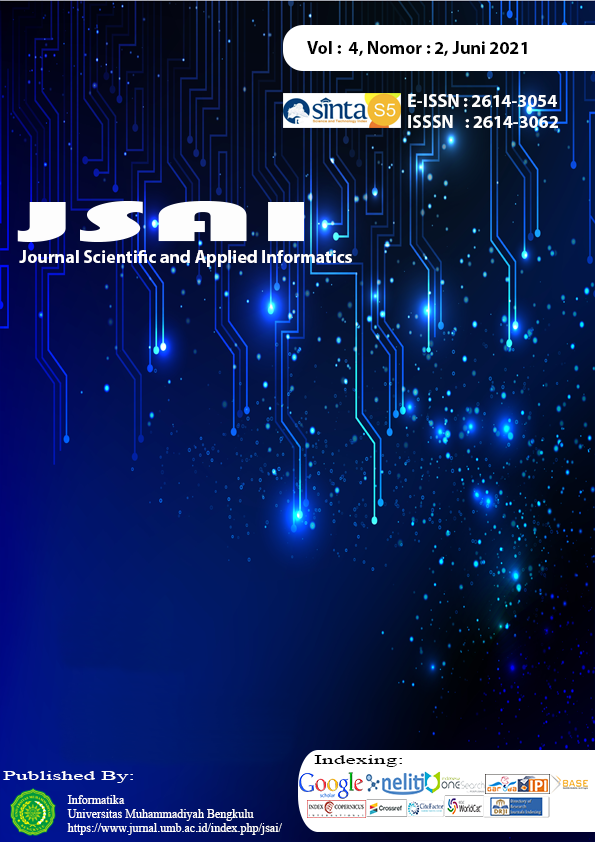Perbandingan Metode Pembelajaran Mesin Berbasis Parametrik dan Non-Parametrik Untuk Klasifikasi Diabetic Retinopathy Imagery
DOI:
https://doi.org/10.36085/jsai.v4i2.1668Abstract
Untuk mendeteksi kerusakan retina dapat dilakukan bantuan algoritmapembelajaran mesin. Klasifikasi citra dengan menggunakan machine learning
techniques (MLTs) dapat membantu proses penentuan pasien penderita
diabetic retinopathy (DR). Teknik machine learning yang digunakan dapat
dikelompokkan menjadi nonparametric (support vector machine) dan
parametric (logistic regression). Tahap penelitian termasuk persiapan,
ekstraksi fitur, normalisasi, klasifikasi, evaluasi dilakukan terhadap dataset
gambar digital fundus yang disediakan oleh EyePACS. Model klasifikasi
menggunakan model nonparametric (support vector machine) dan parametric
(logistic regression). Sebagai hasil, metode logistic regression mendapatkan
hasil akurasi (accuracy) sebesar 74%, recall sebesar 74%, presisi (precision)
sebesar 60% dan F1-score sebesar 63%. Selain itu, metode support vector
machine mendapatkan hasil akurasi (accuracy) sebesar 74%, recall sebesar
74%, presisi (precision) sebesar 55% dan F1-score sebesar 63%
References
A. K. Poddar et al., “Prevalence and causes of avoidable blindness and visual impairment, including the prevalence of diabetic retinopathy in Siwan district of Bihar, India: A population-based survey,†Indian J. Ophthalmol., vol. 68, no. 2, p. 375, 2020.
F. C. Sasso et al., “Telemedicine for screening diabetic retinopathy: The NO BLIND Italian multicenter study,†Diabetes. Metab. Res. Rev., vol. 35, no. 3, p. e3113, 2019.
N. Gerrits et al., “Age and sex affect deep learning prediction of cardiometabolic risk factors from retinal images,†Sci. Rep., vol. 10, no. 1, pp. 1–9, 2020.
K. Al-Fawaz, K. Al Rubaie, Y. Zia, and R. Khandekar, “Comparison of Digital Retinal Images and Information Tele-Transferred Through the Hala System to Manual Image Transfer of Diabetic Patients from Primary Health Care Centers in Riyadh,†Telemed. e-Health, 2020.
A. Waqas, S. H. Teoh, L. V. Lapão, L. A. Messina, and J. C. Correia, “Harnessing Telemedicine for the Provision of Health Care: Bibliometric and Scientometric Analysis,†J. Med. Internet Res., vol. 22, no. 10, p. e18835, 2020.
S. Park, J. Lee, and Y. Son, “Predicting market impact costs using nonparametric machine learning models,†PLoS One, vol. 11, no. 2, p. e0150243, 2016.
A. M. Kotlar, B. V Iversen, and Q. de Jong van Lier, “Evaluation of parametric and nonparametric machineâ€learning techniques for prediction of saturated and nearâ€saturated hydraulic conductivity,†Vadose Zo. J., vol. 18, no. 1, pp. 1–13, 2019.
A. R. Mondal, M. A. E. Bhuiyan, and F. Yang, “Advancement of weather-related crash prediction model using nonparametric machine learning algorithms,†SN Appl. Sci., vol. 2, no. 8, pp. 1–11, 2020.
B. Liu, L. Gao, B. Li, R. Marcos-Martinez, and B. A. Bryan, “Nonparametric machine learning for mapping forest cover and exploring influential factors,†Landsc. Ecol., vol. 35, no. 7, pp. 1683–1699, Jul. 2020.
P. Fernandez-Zelaia, Y. C. Yabansu, and S. R. Kalidindi, “A Comparative Study of the Efficacy of Local/Global and Parametric/Nonparametric Machine Learning Methods for Establishing Structure–Property Linkages in High-Contrast 3D Elastic Composites,†Integr. Mater. Manuf. Innov., vol. 8, no. 2, pp. 67–81, 2019.
S. Aslani and H. Sarnel, “A new supervised retinal vessel segmentation method based on robust hybrid features,†Biomed. Signal Process. Control, vol. 30, pp. 1–12, 2016.
J. Wu, H. Zhang, and X. Ran, “Nonparametric regression algorithm for short-term traffic flow forecasting based on data reduction and support vector machine,†J. Highw. Transp. Res. Dev. (English Ed., vol. 14, no. 3, pp. 96–103, 2020.
Z. Wang, H. Xu, L. Xia, Z. Zou, and C. G. Soares, “Kernel-based support vector regression for nonparametric modeling of ship maneuvering motion,†Ocean Eng., vol. 216, p. 107994, 2020.
A. Soula, K. Tbarki, R. Ksantini, S. Ben Said, and Z. Lachiri, “A novel incremental Kernel Nonparametric SVM model (iKN-SVM) for data classification: An application to face detection,†Eng. Appl. Artif. Intell., vol. 89, p. 103468, 2020.
A. Ghasemzadeh, B. E. Hammit, M. M. Ahmed, and R. K. Young, “Parametric ordinal logistic regression and non-parametric decision tree approaches for assessing the impact of weather conditions on driver speed selection using naturalistic driving data,†Transp. Res. Rec., vol. 2672, no. 12, pp. 137–147, 2018.
D. W. Hosmer Jr, S. Lemeshow, and R. X. Sturdivant, Applied logistic regression. Vol. 398. John Wiley & Sons, 2013.
C. I. Sánchez, R. Hornero, A. Mayo, and M. GarcÃa, “Mixture model-based clustering and logistic regression for automatic detection of microaneurysms in retinal images,†in Medical Imaging 2009: Computer-Aided Diagnosis, 2009, vol. 7260, p. 72601M.
S. Nusinovici et al., “Logistic regression was as good as machine learning for predicting major chronic diseases,†J. Clin. Epidemiol., vol. 122, pp. 56–69, 2020.
M. De Cock, R. Dowsley, A. C. A. Nascimento, D. Railsback, J. Shen, and A. Todoki, “High performance logistic regression for privacy-preserving genome analysis,†BMC Med. Genomics, vol. 14, no. 1, pp. 1–18, 2021.
V. N. Vapnik, “An Overview of Statistical Learning Theory,†vol. 10, no. 5, pp. 988–999, 1999.
D. W. Hosmer and S. Lemeshow, “Applied Logistic Regression.†New York: John Wiley & Sons, Inc, 2000.
S. R. Manne et al., “Efficient Screening of Diseased Eyes based on Fundus Autofluorescence Images using Support Vector Machine,†arXiv Prepr. arXiv2104.08519, 2021.
P. R. R. Chandni, “Anomaly Prognostication of Retinal Fundus Images Using EALCLAHE Enhancement and Classifying with Support Vector Machine,†in Machine Learning, Deep Learning and Computational Intelligence for Wireless Communication, Springer, 2021, pp. 605–617.
K. P. Shung, “Accuracy; Precision; Recall or F1?,†Towards Data Science, 2018. [Online]. Available: https://towardsdatascience.com/accuracy-precision-recall-or-f1-331fb37c5cb9. [Accessed: 12-Mar-2020].
R. Joshi, “Accuracy, Precision, Recall & F1 Score: Interpretation of Performance Measures,†Exsilio Solutions, 2016. [Online]. Available: https://blog.exsilio.com/all/accuracy-precision-recall-f1-score-interpretation-of-performance-measures/. [Accessed: 12-Mar-2020].







